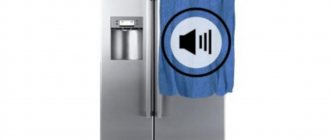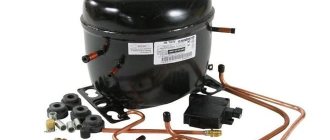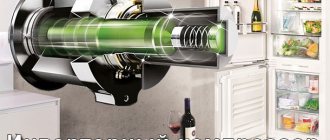If the refrigerator compressor is hot, this could mean either improper operation or a breakdown of the device. Even a minor malfunction of the device can lead to food spoilage. Therefore, users try to monitor the condition of the refrigeration unit. Testing should begin by identifying the area of increased heating.
Compressor operating principle
A standard compressor unit works with the main element in the cooling system of the main and freezer chambers: freon, with the help of the chemical properties of which cooling occurs. The evaporator chamber transfers freon flows to the compressor, which filters them and redirects them to the condenser (it is at this stage that the device becomes very hot).
In the condenser, the freon cools and turns into a liquid, after which the liquid freon (serving as the main “source of cold” in the system) is sent further through the “pipeline” of the cooling system into the chambers, turning back into gas in the process. After this, the work cycle repeats.
Now that we know in general terms the operating algorithm of the refrigeration unit, we can move on to considering the main problems in its operation.
Reasons when the refrigerator compressor gets very hot, which you can deal with yourself
- The “Super Freeze” mode is turned on. Because of this, the motor runs constantly and gets very hot. This mode is designed for quickly freezing food in the freezer. In some refrigerators it can be turned off manually. Turn off the mode according to the instructions if you had “Super Freeze” turned on.
- “Fast cooling” mode is enabled. A function similar to the “Super Freeze” mode, only for the refrigerator compartment. Designed for rapid cooling of large volumes of food in the refrigerator compartment. Disable the mode if you forgot to turn it off.
- Placement of hot products. Leads to longer operation of the compressor without shutting down and overheating.
- The door is slightly open. Because of this, warm air enters the chamber, and the motor has to work constantly. As a result, it gets very hot.
- Rare defrosting. Check the instructions: models without No Frost need to be defrosted at least once every 6-12 months. Otherwise, the snow coat in the freezer will prevent the effective transfer of cold from the evaporator, and the motor, operating with rare shutdowns, will be very hot.
- Incorrect placement of food in the refrigerator. If you fill the refrigerator so much that you block the channels for supplying cooled air to the refrigerator compartment, the cooling efficiency will decrease, and the refrigerator will try to compensate for the lack of cooling by constantly working, which will cause the refrigerator compressor to get very hot.
- Incorrect installation. The distance from the warm grill at the back of the refrigerator (condenser) to the wall must be at least 5 cm. Also, the refrigerator should not be adjacent to the stove or heating appliances. Poor ventilation reduces the heat exchange between the condenser and the environment and increases the load on the compressor.
Should the compressor get hot?
As with most electrical appliances, there is a certain “working rate” of heating for the compressor. Depending on the model and design features, it can range from +60 to +90 degrees Celsius, but no more. Taking this fact into account, we can conclude that the compressor really should be hot during operation, and sometimes even heat up to fairly high temperatures. However, if it “heats” to a temperature above +90, then this clearly indicates a problem during operation.
Important! In addition to overheating, a number of factors may indicate malfunctions in the compressor, such as light electrical discharges when touching the surface of the device, insufficient cooling of the chambers, or the formation of an ice crust on the walls of the chamber.
If a working refrigerator begins to show similar symptoms, this is a reason to contact a repair company or place of purchase for warranty service. It is worth noting that warranty repairs most often do not cover equipment that has mechanical damage, so you should be especially careful when using the device during the warranty period.
Hot sides of the refrigerator
If the sides of the refrigerator heat up, and not the back, there is no need to sound the alarm either. It is better to become familiar with the mechanics of the device of a particular model, because the network of tubes that provides cooling can be located on the sides, that is, in the side walls. And since this does not change the mechanics of operation and the compressor also heats up during operation, the walls where the cooling system is located also heat up.
However, if the compression unit is located on the back wall of the refrigerator, this may be an alarming signal and indicate a problem.
The influence of external factors should also not be excluded. So, if the refrigerator is located near an oven or stove, the sides may heat up under the thermal influence of these appliances. Such exposure can negatively affect the performance of the refrigerator, so placing these items nearby should be avoided.
Why is the compressor hot?
If we do not consider “normal” overheating of the unit under normal operating conditions, then very strong heating of the compressor (to a temperature above 90 degrees) may indicate the following reasons:
- continuous operation of the unit without shutting down when the desired temperature is reached;
- continuous work in extreme heat;
- heat exchanger malfunctions;
- freon leakage from the system;
- cells overflowing with food;
- operation in intensive freezing mode;
- thermostat turned to maximum;
- improper operating conditions.
In addition, the compressor may overheat slightly after the refrigerator has been defrosted. Excessively frequent opening of chamber doors also leads to rapid failure of the unit (this often happens to those who try to limit food consumption, but regularly look into the refrigerator in order to “snack” something low-calorie).
It is important to note that even the highest quality refrigeration units have their service life, and after 10–15 years of service they begin to require major repairs.
However, even these 10–15 years, the device will last only if all operating standards are observed and the condition of the main components is regularly monitored. As in the case of a car engine, even one minor breakdown that is not repaired in time can lead to serious problems in the cooling system, including its complete replacement.
Possible faults
We have repaired tens of thousands of refrigerators, and we can accurately outline the range of possible breakdowns when the compressor is very hot. Here they are in the table.
Wear or damage to the door seal - from RUB 1,200.
As a result, the door allows warm air into the chamber. To compensate for the heat coming from outside, the motor operates with rare shutdowns.
Signs
The compressor runs almost non-stop and gets very hot. The refrigerator door does not fit tightly.
How to fix
The seal needs to be replaced.
Temperature sensor or thermostat that turns off the cooling - from 1,400 rubles.
The signal that the set temperature has been reached from the sensor does not reach the control module, so the compressor runs without stopping.
Signs
The refrigerator freezes, the motor is very hot and runs constantly.
How to fix
The sensor or thermostat needs to be replaced.
Control unit - from 1900 rub.
The module incorrectly processes data from the temperature sensor and turns off cooling late. Therefore, the motor works with increased load and gets very hot.
Signs
The refrigerator freezes, the motor is very hot and runs constantly.
How to fix
The control module needs to be repaired or replaced.
Clogged capillary pipeline - from RUB 1,800.
Due to the blockage, the compressor cannot pump freon through it in the required volume, so it works without shutting down and overheats.
Signs
The refrigerator does not cool well, the motor is hot and works with rare shutdowns.
How to fix
The technician pushes through the blockage or completely changes the capillary tube.
Defrosting in No Frost refrigerators - from 1400 rubles.
One or more defrost components fail: fuse, defrost sensor, heating element or defrost timer.
Signs
There is a lot of ice in the freezer compartment of the No Frost refrigerator, and the refrigerator compartment does not cool, while the compressor is hot and runs non-stop. Defrosting helps solve the problem for a short time, but after one or two weeks it happens again.
How to fix
Defrost needs repair.
Refrigerant leak - from 2000 rubles.
It happens in the steel heating circuit of the freezer perimeter, in places of factory rations or in a crying evaporator. The refrigerator tries to compensate for the lack of freon by constantly running the motor, so the compressor runs without turning off and gets very hot.
Signs
The refrigerator does not freeze, the compressor is very hot and runs constantly.
How to fix
You need to find the leak, fix it and fill the refrigerator with refrigerant.
Compressor - from 1900 rub.
An interturn short circuit has occurred in the starting or operating winding of the motor.
Signs
The refrigerator does not work or turns on and then turns off immediately. If you touch the compressor, it is very hot.
Should the compressor and motor in the refrigerator be hot?
Obviously, the compressor performs a rather complex function, which is why heating occurs. Indeed, in order to achieve the required state of aggregation of the coolant, very high pressure has to be applied. In addition, the coolant transfers a certain amount of thermal energy.
As for the refrigerator motor, it is also normal to heat up. To operate a refrigerator, it is necessary to generate a sufficiently large amount of electric current, which entails heating.
But don't forget that excessive heat is not normal. And if suspicions arise about this, then it is better to measure the temperature of these elements.
How does a refrigerator work and what is a heat pump?
People who are at least a little familiar with technology know that a refrigerator, at its core, is a device called a heat pump. That is, special equipment that pumps the thermal energy of a substance from one place to another. In the case of a refrigerator, such pumping occurs in the direction from the refrigerator (freezer) chamber to the outside. That is, the lower temperature inside is achieved due to the fact that the temperature somewhere outside becomes high.
Content:
How does a refrigerator work and what is a heat pump? Why do the walls get hot? Why does the compressor get hot? Reviews
Signs of a faulty refrigerator
It is usually not difficult to understand that the refrigerator has begun to work differently than intended by the manufacturer. The first sign is poor cooling of the food inside . But there are some other clear signs of problems:
- if the compressor shuts down immediately after turning it on;
- the compressor does not turn on at all or does not circulate the refrigerant (warm or hot air is supplied inside);
- significant appearance of condensation;
- rapid formation of a snow cap inside the chamber;
- the walls of the unit are electrocuted.
Not all of these problems are easy to solve on your own. For example, insufficient cooling (due to improper placement) can be resolved by moving the refrigerator.
Advice! Problems with the operation of the compressor, condenser and other internal parts are best left to professional technicians. They have the experience and the right tools to fix the breakdown or completely replace the part.
Source
Possible reasons and their solution
If the refrigerator compressor is excessively hot due to improper placement of the unit, it is enough to correct its position relative to the floor covering.
This is done by adjusting the height of the legs. To ensure optimal air exchange from the rear grille (the heating intensity also depends on this), you need to maintain a distance of 15-20 cm from the wall. If there are no problems with the placement of the equipment, you should try to defrost the chambers. After complete defrosting, the compartments are reloaded with products, taking into account the key rules that are indicated in the instruction manual. As an additional measure, you should check the temperature sensor using a multimeter. Failed sensors need to be replaced.
It is forbidden to try to disassemble the compressor with your own hands.
This should be carried out by a trained professional using suitable tools.
If the above measures do not lead to positive results, and the compressor continues to heat up, it is necessary to carry out a series of repairs, first turning off the power and emptying the refrigerator.
To fix the problem, you can do the following:
- Drain the coolant from the system. The action is performed by breaking the tube that goes to the compressor and starting the motor for a short period of time. The refrigerant goes into the condenser and is then pumped out of the refrigerator using a cylinder and hose.
- Replace the filling tube. When carrying out the procedure, it is better to install a copper tube that easily connects to the body.
- Get the compressor. The unit must be removed from its mountings. Install the new compressor in reverse order.











